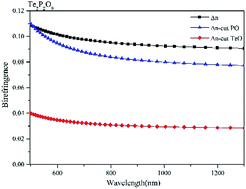Tellurium–oxygen group enhanced birefringence in tellurium phosphates: a first-principles investigation†
Abstract
Phosphates possess a relatively large UV/DUV cutoff edge, but these compounds usually have very small birefringence. Recently the Te2P2O9 crystal was synthesized and its birefringence was reported to be as large as 0.106 at 1013.98 nm. Herein, we investigated the electronic structure and optical properties of Te2P2O9 using the first-principles method. The obtained results are in good agreement with the experimental values. The Born effective charges and SHG density of Te2P2O9 show that the contribution to the birefringence and SHG response mainly originates from the TeO5 group. The electronic structures and optical response of Ba2TeO(PO4)2 and Te3O3(PO4)2 were also investigated for comparison. The results show that these two tellurium phosphates also possess a large birefringence similar to Te2P2O9. Also, the birefringence originates from the TeOx polyhedrons, which was confirmed by the real-space atom-cutting results and distortion indices.



 Please wait while we load your content...
Please wait while we load your content...